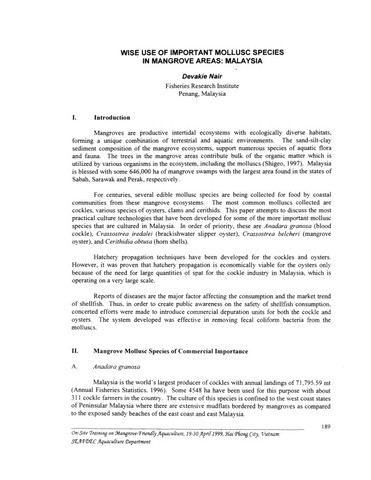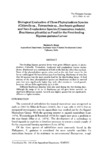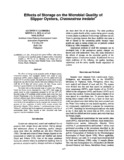Early development of Crassostrea iredalei (Faustino, 1932) (Bivalvia: Ostreidae), with notes on the structure of the larval hinge
Share
Abstract
Larvae of the oyster Crassostrea iredalei were reared in the laboratory from eggs through settlement. The oysters were induced to spawn by increasing the temperature by 5-10°C and sometimes by adding stripped oyster sperm to the spawning dishes. Eggs avareaged 48 µm in diameter.
The straight-hinge veligers appeared 22 to 26 h after fertilization. The larval shell length increased from 64 to 84 µm in the straight-hinge stage, from 85 to 275 µm in the umbo stage, and from 210 to 275 µm in the pediveliger stage. Eye-spotted pediveligers were observed mostly at lengths greater than 225 µm. The hinge line did not increase much with larval growth. Although length was initially greater than height, the increase in height was much faster due to the development of the umbo. Height was greater than length in more advanced larvae. Valve growth was asymmetrical and unequal, with the left valve generally larger. Settlement and metamorphosis occurred 20 days from fertilization at lengths of 270 µm and greater, when the oyster larvae were reared at 26.5 to 30°C and salinities of 30 to 32 ppt.
The larval hinge structure consisted of minute dentition on the central portion of the provinculum and large rectangular teeth on both ends. These teeth became obscured in advanced larvae due to the skewed development of the umbo.
Data derived from the laboratory culture of larvae of Crassostrea iredalei may be used in spatfall forecasts for the collection of larvae from the wild and as baseline information for the hatchery culture of oyster larvae.
Description
SEAFDEC Aquaculture Department Contribution No. 158.
Suggested Citation
Ver, L. M. M. (1986). Early development of Crassostrea iredalei (Faustino, 1932) (Bivalvia: Ostreidae), with notes on the structure of the larval hinge. Veliger , 29(1), 78-85. http://hdl.handle.net/10862/1201
Subject
Taxonomic term
Collections
- AQD Journal Articles [1248]
Related items
Showing items related by title, author, creator and subject.
-
Wise use of important mollusc species in mangrove areas: Malaysia
Nair, Devakie (Aquaculture Department, Southeast Asian Fisheries Development Center, 2000)For centuries, several edible mollusc species are being collected for food by coastal communities from these mangrove ecosystems. The most common molluscs collected are cockles, various species of oysters, clams and ... -
Biological evaluation of three phytoplankton species (Chlorella sp., Tetraselmis sp., Isochrysis galbana) and two zooplankton species (Crassostrea iredalei, Brachionus plicatilis) as food for the first-feeding Siganus guttatus larvae
Duray, Marietta N. (University of San Carlos, 1986)First-feeding Siganus guttatus larvae were given different species of phytoplankton (Chlorella, Tetraselmis, Isochrysis) and zooplankton (oyster trochophores, Brachionus) or a combination of both on the first day when they ... -
Effects of storage on the microbial quality of slipper oysters, Crassostrea iredalei
Llobrera, Alcestis T.; Bulalacao, Minvilu L.; Suñaz, Ning. (Asian Fisheries Society, 1986)The effects of storage on the microbial quality of slipper oysters, Crassostrea iredalei, were examined. Oysters were stored at room temperature (24°C), under a blanket of ice (3-4 C), chilled (4-C) and frozen (-25°C) until ...






